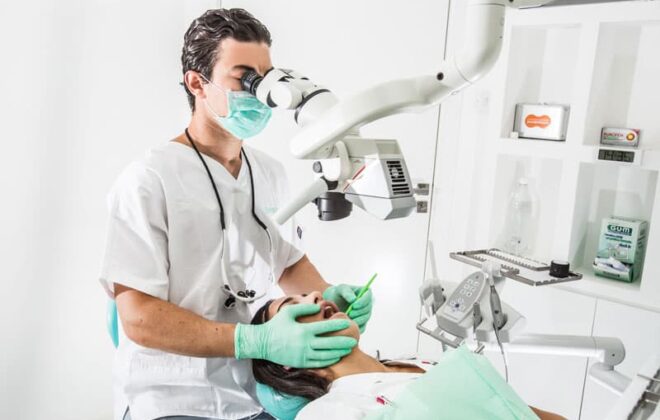What to Do When a Dental Crown Becomes Dislodged
If you’ve ever cracked a tooth, there’s a good chance that a dentist may have said you need a crown. A dental crown is a cap for a damaged tooth. Unlike a veneer, which only covers the front of a tooth, a crown typically covers most or all of it. It’s designed to support the weak or damaged tooth.
Depending on the material the crown is made from, it should last for a number of years. However, it’s possible that your crown might come loose or even fall out before it’s due to be replaced. If your crown does become dislodged or falls out, it’s important to know how to handle the situation.
What to do if your crown fell out
Imagine this scenario: You take a bite, only to feel something strange and lumpy on your tongue. Your crown has become dislodged and is floating around in your mouth.
If this happens to you, the most important thing is to retrieve the crown so you can take it to a dentist. There’s a chance that they can clean it up and fit it back into your mouth.
Next, call a dentist to make an appointment. You’ll need to either get the crown replaced or get a new one. Ask the dentist if there are any other special instructions that you should follow until your appointment.
Some dentists might suggest that you try reinserting the crown back into its spot. You would need to gently clean the inside of the crown with toothpaste first. Then, use dental adhesive (or even toothpaste or sugar-free gum) to temporarily “glue” the crown back into its spot on your jawline. You can buy temporary dental cement at a pharmacy or grocery store.
Until you get your new crown, you should also try to be careful when eating and avoid chewing on the crown. Stick to soft foods and liquids until you can get it replaced.
What not to do if your crown fell out
The most important thing to remember if your crown comes loose is this: Don’t swallow it! If it falls out of your mouth, be sure to find it and hold on to it.
Other important steps to take while you’re missing a crown in your mouth:
- Avoid foods that are sticky, hard, or require a lot of chewing.
- Try to avoid chewing food on the affected side of your mouth.
- Be gentle when brushing your teeth.
What if a temporary crown fell out?
Unless you get a same-day crown, a dentist will usually install a temporary crown first. Think of this as a placeholder. It’s filling in the spot in your mouth where your permanent crown will eventually be installed. You might have a temporary crown for a couple of weeks.
Since temporary crowns are typically installed with temporary cement, you may need to be extra careful with it. Your dentist will probably suggest avoiding hard, chewy and sticky foods.
Even with care and attention, it’s possible for a temporary crown to come out. Be sure to tell your dentist and ask for instructions. In the meantime, follow the same basic protocol that you would if a permanent crown falls out.
Treating teeth after a crown falls out
After your crown becomes dislodged, a dentist will evaluate both the site of the crown and the crown itself.
Depending on the integrity of the crown and the status of your mouth, they’ll have to decide whether to reinstall the crown or to create and install a new one.
Some research suggestsTrusted Source that it can be possible to use an existing crown even if your tooth is fractured underneath, although it may need a little work before it can be reinstalled. However, if your tooth underneath is broken, you may need a new crown to ensure a perfect fit.
If you need a new crown and your tooth is damaged, a dentist will need to prepare your tooth, which may mean filing the tooth or adding some filling material to build it up. Then, the dentist will install a temporary crown to allow for some time to make the new one.
Some dentists also offer same-day crowns made out of very strong ceramic material like CEREC. You can forego the temporary crown in this situation.
Why do dental crowns come loose?
You may not even realize that your crown has become loose until it actually falls out. There are a variety of reasons, however, that it can happen.
Sometimes, you can develop tooth decay in the remainder of the tooth under the crown. Bacteria can creep up under the crown and cause decay to begin, especially if some of the cement gets worn or washed away. As the decay takes hold, it can affect the fit of the crown.
The crown may become loose and more prone to falling out. Sometimes, there’s just not enough tooth left to hold a crown firmly in place.
Other causes of loose crowns can include:
- an improperly fitted crown
- not enough cement holding the crown in place
- sticky foods that pull a crown out of place
- grinding your teeth
- a seriously weakened tooth
Sometimes a crown will only get partially dislodged. If it’s hanging precariously by one side, you might want to go ahead and remove the crown.
Can you prevent a crown from falling out?
There’s not much you can do if your crown wasn’t properly fitted into your mouth or if the cement has weakened. But you can still be proactive about taking care of your crown to reduce the chances that it will come loose.
A few steps recommended by the Academy of General Dentistry include:
- don’t chew ice
- avoid or be very careful eating very sticky or chewy foods
- brush your teeth twice a day
- floss regularly
- use an interdental brush (a wider brush that goes in between teeth like floss) to remove any plaque from the area where your gum meets the tooth and crown
If you grind your teeth at night, a dentist might also recommend that you wear a mouthguard to protect your crown and your other teeth.
Takeaway
If you lose a crown, you’re not the first or the last person to do so. The most important thing to remember is to call a dentist to schedule an appointment to have the crown refitted or replaced. In the meantime, hold onto the crown and go easy on your mouth when eating.



